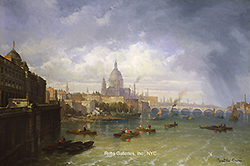BIOGRAPHY - Pierre-Justin Ouvrié (1806 - c. 1879)
Pierre-Justin Ouvrié was a painter of architectural sites, mansions, monuments, and landscapes in France and abroad. With more than forty years of successive Salon entries, Ouvrié’s illustrious career showed that paintings romanticizing architectural landscapes were an accepted tradition of imagery in the Salons. Louis Auvray, in his Salon de 1865, wrote about his interest in the work of the artist:
For thirty-one years we have appreciated in the press the work of M. Justin Ouvrié, we have followed his progress with the strongest interest and applauded his successes.
Though well known during the nineteenth-century, little accurate information has been passed down to us about the artist’s life and work aside from a few mentions of some of his works in museums and galleries or mentioned in old Salon catalogues.
The lack of information on Pierre-Justin Ouvrié has led to conflicting dates for his birth and death. Two dates have been proposed for both: his birthdate is either January 19 or May 9, 1806 and his death is either October 23, 1879 or 1880, though most likely it was in 1879. It is clear that he was born in Paris and died in Rouen. His later Salon entries show that he was a student of three masters concurrently: Alexandre-Denis Abel de Pujol, Baron Taylor, and the architect Chatillon, most likely Andre-Marie Chatillon, though no first name is provided in the Salon catalogs. It is interesting to note that the Chatillon was an architect by trade, which may have influenced, if not encouraged, Ouvrié’s depictions of architectural monuments.
By 1827, Ouvrié had established himself well enough to receive significant commissions. In 1827 he completed Un Portrait du Roi en Pied (Full-Length Portrait of the King), for the city of Dôle and in 1829 he completed Un Portrait du Roi, Buste (A Portrait of the King, Bust) for the city of Villefranche, suggesting that his career was closely linked to the Restoration period of Charles X. At this time Ouvrié was also working in lithography, a medium that was becoming increasingly popular at the time. As many artists of this period, Ouvrié began his artistic career with commissioned portraits, but later found his true passion in paintings of architecture and landscape.
Ouvrié’s most considerable contribution was to the Salons. Before exhibiting at the Salons, however, he exhibited Vue Prise à Moret (View at Moret), a watercolor, at the Exposition du Luxembourg in 1830. Ouvrié often completed his watercolors on the spot and these would later figure in important aspects of his Salon entries. Over a forty year period of Salon exhibitions, his accepted entries totaled more than 150 paintings, exhibiting as many as six at a time. He exhibited under several names, at times Ouvrié, at other times Pierre-Justin, Justin or Justin Ouvrié, thereby confusing possible attributions. He first exhibited at the Salon of 1831 and received a second class medal for Genre et Paysage (Genre and Landscape), an impressive showing considering it was his first Salon exhibition. By 1833 he had begun his series of extensive travels and that same year exhibited two views of Venice and Naples: his works were inspired by these journeys. Ouvrié’s travels took him throughout France, Holland, Belgium, Switzerland, Germany, England, and Italy and provided him with ample and diverse subject matter.
His travels through Italy may have inspired his appreciation of architecture and architectural ruins. Ouvrié’s work glorified architectural details with a reliance on precise representation. In l’Artiste for 1840, the well-known critic, Jules Janin, wrote about Ouvrié’s personal approach to architecture and that he:
…understands admirably the noble and severe beauties of architecture, and, in consequence, he reproduces them not like an architect, but like a painter.
His work can thus be viewed in the context of the cult of the picturesque, where artists were frequently commissioned to study ruins as one way of providing images fore eventual use in travel publications. Ouvrié translated his travels abroad into romanticized versions of reality. His teacher, if it was indeed Andre-Marie Chatillon, as is likely, was also a student in Italy, traveling throughout cities such as Naples and Florence. Ouvrié’s depictions of the picturesque are influenced by both travel and tutelage.
Ouvrié continued exhibiting both oil and watercolor paintings at the Salons through 1871. He later received a first class medal in 1843 and a third class medal in 1855. His greatest honor came December 30, 1854 when he received the title of Chevalier de la Légion d’Honneur. Ouvrié died in 1879 or 1880 in Rouen.
Selected Museums
Louvre
Musée des Beaux-Arts, Troyes
Musée National du Château, Fontainebleau

